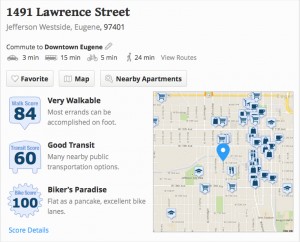
Occasionally, we have friends and acquaintances ask us where we are building and we reply “downtown Eugene.” To which we usually get one of three responses: 1. “There is a vacant lot downtown?”, 2. “Why?”, 3. “Awesome”. In response to number 1, yes, there are a few vacant lots downtown (we purchased ours in 2009) and to number 3, thanks, we think so, too.
This post is more in response to number 2, the “why.” There are many reasons that I won’t go into here right now, but one is the walkability and bikeability of the neighborhood. Brenda and I love walking and biking. When we lived on the hill, walking was easier than biking. But now that we are going to live downtown, there is just so much more activity nearby: restaurants, the library, shops, the Saturday and Farmers Markets.
As you can see in the graphic posted here, our new home will be very walkable and VERY bikeable. The higher the walkscore, the better. (Check out more here about walkscore).
I wanted to quote an excerpt from a wonderful book about walkability. The book is Walkable City, by Jeff Speck. And one paragraph sums it up very succinctly for us. It’s about the empty nesters (which we are):
“With the leading edge of the boomers now approaching sixty-five years old, the group is finding that their suburban houses are too big. Their child-rearing days are ending, and all those empty rooms have to be heated, cooled, and cleaned, and the unused backyard maintained… Freedom for many in this generation means living in walkable, accessible communities with convenient transit linkages and good public services like libraries, cultural activities, and health care.”
And I might add, Cornucopia just three blocks away. Best burgers in town.



